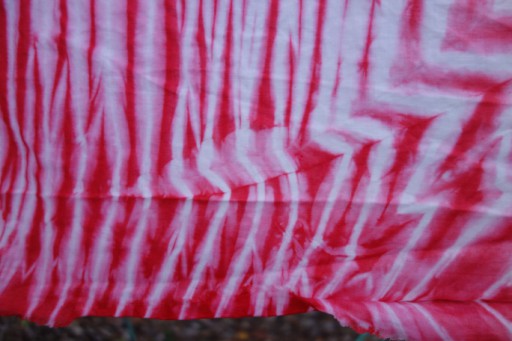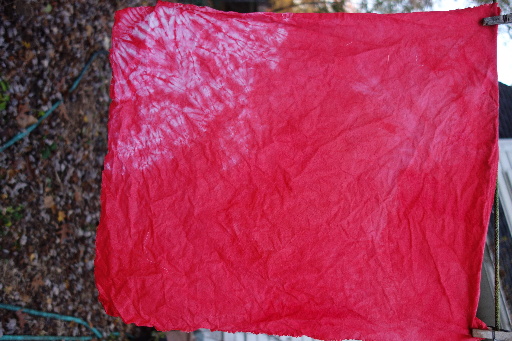Japan is a producer of hand-made textiles par excellence; my first introduction to them was traditional silk embroidery (nui-do, iirc); and then there's also temari and kumihimo, the former originating in Japan, the latter taken to superb heights.
One other area they've developed to its highest pitch is shibori: a form of resist dying using bindings, such as string or clamped blocks. The so-called fawn-spot design is the most familiar, and highly revered because of its incredibly time-consuming technique.[1] But the form of shibori that fascinated me the most was arashi (storm), the pole wrapping technique developed specifically to speed up production and make shibori more competitive.
Recently I finally got around to trying it. I didn't attempt anything fancy, allowing the fabric to lap (fold), twist, etc as I wrapped it on the pole. My friend Page is taking a fabric dying class and she helped me a good deal:)
Another, slower technique that I really like is the stitched moku-magane (wood-grain) pattern. This is best known in married metals, but is also applied to certain hand stitched resists. I wasn't as successful with this one:
But it was all just so much fun. We've had exceptionally warm weather, all the way into November, but I think more of this will have to wait till next year.[2] In the meantime, however, I can plan. And if my decidedly amateurish efforts are at all inspiring, the book to learn all this stuff that I can heartily recommend is Shibori (and hey, the price has really dropped, too!)[3]
[1]Let's be honest, fawn-spot eventually became a sign of wealth and conspicuous consumption.
[2]Dyeing is typically an outdoor activity for me. I don't really care if I get dye all over the deck or the grass.
[3]This is very much a techniques manual; there are a few coloured images, but even the black and white examples are to my mind just gorgeous.
Unless otherwise noted, text, image and objects depicted therein copyright 1996--present sylvus tarn.
Sylvus Tarn


